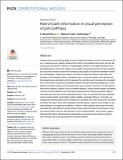Role of path information in visual perception of joint stiffness
Author(s)
West, A. Michael; Huber, Meghan E.; Hogan, Neville
Downloadjournal.pcbi.1010729.pdf (1.512Mb)
Publisher with Creative Commons License
Publisher with Creative Commons License
Creative Commons Attribution
Terms of use
Metadata
Show full item recordAbstract
Humans have an astonishing ability to extract hidden information from the movement of others. In previous work, subjects observed the motion of a simulated stick-figure, two-link planar arm and estimated its stiffness. Fundamentally, stiffness is the relation between force and displacement. Given that subjects were unable to physically interact with the simulated arm, they were forced to make their estimates solely based on observed kinematic information. Remarkably, subjects were able to correctly correlate their stiffness estimates with changes in the simulated stiffness, despite the lack of force information. We hypothesized that subjects were only able to do this because the controller used to produce the simulated arm’s movement, composed of oscillatory motions driving mechanical impedances, resembled the controller humans use to produce their own movement. However, it is still unknown what motion features subjects used to estimate stiffness. Human motion exhibits systematic velocity-curvature patterns, and it has previously been shown that these patterns play an important role in perceiving and interpreting motion. Thus, we hypothesized that manipulating the velocity profile should affect subjects’ ability to estimate stiffness. To test this, we changed the velocity profile of the simulated two-link planar arm while keeping the simulated joint paths the same. Even with manipulated velocity signals, subjects were still able to estimate changes in simulated joint stiffness. However, when subjects were shown the same simulated path with different velocity profiles, they perceived motions that followed a veridical velocity profile to be less stiff than that of a non-veridical profile. These results suggest that path information (displacement) predominates over temporal information (velocity) when humans use visual observation to estimate stiffness.
Date issued
2022-11-28Department
Massachusetts Institute of Technology. Department of Mechanical Engineering; Massachusetts Institute of Technology. Department of Brain and Cognitive SciencesJournal
PLOS Computational Biology
Publisher
Public Library of Science (PLoS)
Citation
West AM Jr, Huber ME, Hogan N (2022) Role of path information in visual perception of joint stiffness. PLoS Comput Biol 18(11): e1010729.
Version: Final published version
ISSN
1553-7358
Keywords
Computational Theory and Mathematics, Cellular and Molecular Neuroscience, Genetics, Molecular Biology, Ecology, Modeling and Simulation, Ecology, Evolution, Behavior and Systematics